Mykel J. Kochenderfer
Stanford University
Robust Planning for Autonomous Vehicles with Diffusion-Based Failure Samplers
Jul 16, 2025Abstract:High-risk traffic zones such as intersections are a major cause of collisions. This study leverages deep generative models to enhance the safety of autonomous vehicles in an intersection context. We train a 1000-step denoising diffusion probabilistic model to generate collision-causing sensor noise sequences for an autonomous vehicle navigating a four-way intersection based on the current relative position and velocity of an intruder. Using the generative adversarial architecture, the 1000-step model is distilled into a single-step denoising diffusion model which demonstrates fast inference speed while maintaining similar sampling quality. We demonstrate one possible application of the single-step model in building a robust planner for the autonomous vehicle. The planner uses the single-step model to efficiently sample potential failure cases based on the currently measured traffic state to inform its decision-making. Through simulation experiments, the robust planner demonstrates significantly lower failure rate and delay rate compared with the baseline Intelligent Driver Model controller.
Diffusion Models for Safety Validation of Autonomous Driving Systems
Jun 10, 2025Abstract:Safety validation of autonomous driving systems is extremely challenging due to the high risks and costs of real-world testing as well as the rarity and diversity of potential failures. To address these challenges, we train a denoising diffusion model to generate potential failure cases of an autonomous vehicle given any initial traffic state. Experiments on a four-way intersection problem show that in a variety of scenarios, the diffusion model can generate realistic failure samples while capturing a wide variety of potential failures. Our model does not require any external training dataset, can perform training and inference with modest computing resources, and does not assume any prior knowledge of the system under test, with applicability to safety validation for traffic intersections.
DB-KSVD: Scalable Alternating Optimization for Disentangling High-Dimensional Embedding Spaces
May 24, 2025Abstract:Dictionary learning has recently emerged as a promising approach for mechanistic interpretability of large transformer models. Disentangling high-dimensional transformer embeddings, however, requires algorithms that scale to high-dimensional data with large sample sizes. Recent work has explored sparse autoencoders (SAEs) for this problem. However, SAEs use a simple linear encoder to solve the sparse encoding subproblem, which is known to be NP-hard. It is therefore interesting to understand whether this structure is sufficient to find good solutions to the dictionary learning problem or if a more sophisticated algorithm could find better solutions. In this work, we propose Double-Batch KSVD (DB-KSVD), a scalable dictionary learning algorithm that adapts the classic KSVD algorithm. DB-KSVD is informed by the rich theoretical foundations of KSVD but scales to datasets with millions of samples and thousands of dimensions. We demonstrate the efficacy of DB-KSVD by disentangling embeddings of the Gemma-2-2B model and evaluating on six metrics from the SAEBench benchmark, where we achieve competitive results when compared to established approaches based on SAEs. By matching SAE performance with an entirely different optimization approach, our results suggest that (i) SAEs do find strong solutions to the dictionary learning problem and (ii) that traditional optimization approaches can be scaled to the required problem sizes, offering a promising avenue for further research. We provide an implementation of DB-KSVD at https://github.com/RomeoV/KSVD.jl.
Scalable Importance Sampling in High Dimensions with Low-Rank Mixture Proposals
May 19, 2025Abstract:Importance sampling is a Monte Carlo technique for efficiently estimating the likelihood of rare events by biasing the sampling distribution towards the rare event of interest. By drawing weighted samples from a learned proposal distribution, importance sampling allows for more sample-efficient estimation of rare events or tails of distributions. A common choice of proposal density is a Gaussian mixture model (GMM). However, estimating full-rank GMM covariance matrices in high dimensions is a challenging task due to numerical instabilities. In this work, we propose using mixtures of probabilistic principal component analyzers (MPPCA) as the parametric proposal density for importance sampling methods. MPPCA models are a type of low-rank mixture model that can be fit quickly using expectation-maximization, even in high-dimensional spaces. We validate our method on three simulated systems, demonstrating consistent gains in sample efficiency and quality of failure distribution characterization.
On Technique Identification and Threat-Actor Attribution using LLMs and Embedding Models
May 15, 2025Abstract:Attribution of cyber-attacks remains a complex but critical challenge for cyber defenders. Currently, manual extraction of behavioral indicators from dense forensic documentation causes significant attribution delays, especially following major incidents at the international scale. This research evaluates large language models (LLMs) for cyber-attack attribution based on behavioral indicators extracted from forensic documentation. We test OpenAI's GPT-4 and text-embedding-3-large for identifying threat actors' tactics, techniques, and procedures (TTPs) by comparing LLM-generated TTPs against human-generated data from MITRE ATT&CK Groups. Our framework then identifies TTPs from text using vector embedding search and builds profiles to attribute new attacks for a machine learning model to learn. Key contributions include: (1) assessing off-the-shelf LLMs for TTP extraction and attribution, and (2) developing an end-to-end pipeline from raw CTI documents to threat-actor prediction. This research finds that standard LLMs generate TTP datasets with noise, resulting in a low similarity to human-generated datasets. However, the TTPs generated are similar in frequency to those within the existing MITRE datasets. Additionally, although these TTPs are different than human-generated datasets, our work demonstrates that they still prove useful for training a model that performs above baseline on attribution. Project code and files are contained here: https://github.com/kylag/ttp_attribution.
Model Identification Adaptive Control with $ρ$-POMDP Planning
May 14, 2025Abstract:Accurate system modeling is crucial for safe, effective control, as misidentification can lead to accumulated errors, especially under partial observability. We address this problem by formulating informative input design (IID) and model identification adaptive control (MIAC) as belief space planning problems, modeled as partially observable Markov decision processes with belief-dependent rewards ($\rho$-POMDPs). We treat system parameters as hidden state variables that must be localized while simultaneously controlling the system. We solve this problem with an adapted belief-space iterative Linear Quadratic Regulator (BiLQR). We demonstrate it on fully and partially observable tasks for cart-pole and steady aircraft flight domains. Our method outperforms baselines such as regression, filtering, and local optimal control methods, even under instantaneous disturbances to system parameters.
Managing Geological Uncertainty in Critical Mineral Supply Chains: A POMDP Approach with Application to U.S. Lithium Resources
Feb 08, 2025



Abstract:The world is entering an unprecedented period of critical mineral demand, driven by the global transition to renewable energy technologies and electric vehicles. This transition presents unique challenges in mineral resource development, particularly due to geological uncertainty-a key characteristic that traditional supply chain optimization approaches do not adequately address. To tackle this challenge, we propose a novel application of Partially Observable Markov Decision Processes (POMDPs) that optimizes critical mineral sourcing decisions while explicitly accounting for the dynamic nature of geological uncertainty. Through a case study of the U.S. lithium supply chain, we demonstrate that POMDP-based policies achieve superior outcomes compared to traditional approaches, especially when initial reserve estimates are imperfect. Our framework provides quantitative insights for balancing domestic resource development with international supply diversification, offering policymakers a systematic approach to strategic decision-making in critical mineral supply chains.
A General Bayesian Framework for Informative Input Design in System Identification
Jan 28, 2025



Abstract:We tackle the problem of informative input design for system identification, where we select inputs, observe the corresponding outputs from the true system, and optimize the parameters of our model to best fit the data. We propose a methodology that is compatible with any system and parametric family of models. Our approach only requires input-output data from the system and first-order information from the model with respect to the parameters. Our algorithm consists of two modules. First, we formulate the problem of system identification from a Bayesian perspective and propose an approximate iterative method to optimize the model's parameters. Based on this Bayesian formulation, we are able to define a Gaussian-based uncertainty measure for the model parameters, which we can then minimize with respect to the next selected input. Our method outperforms model-free baselines with various linear and nonlinear dynamics.
Enhanced Importance Sampling through Latent Space Exploration in Normalizing Flows
Jan 06, 2025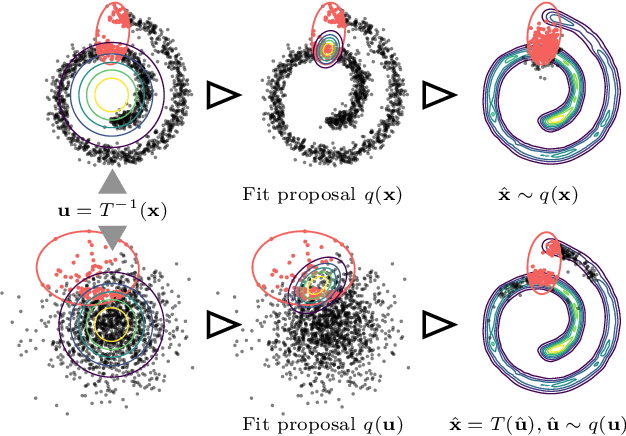
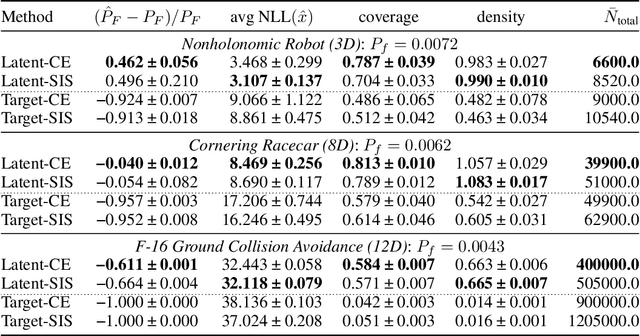
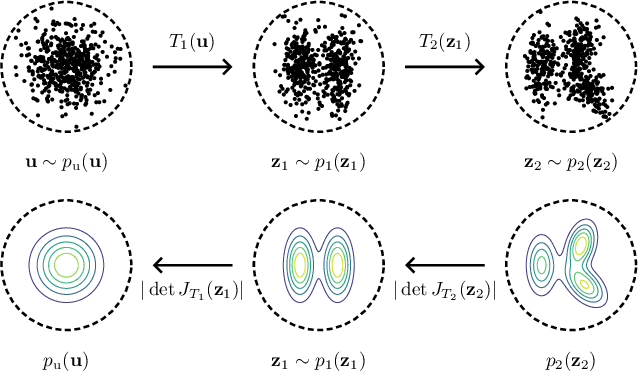
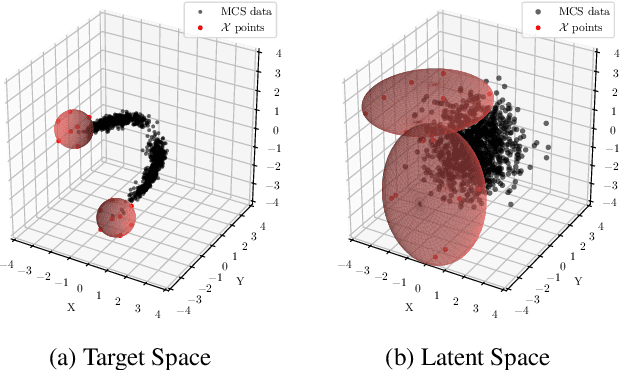
Abstract:Importance sampling is a rare event simulation technique used in Monte Carlo simulations to bias the sampling distribution towards the rare event of interest. By assigning appropriate weights to sampled points, importance sampling allows for more efficient estimation of rare events or tails of distributions. However, importance sampling can fail when the proposal distribution does not effectively cover the target distribution. In this work, we propose a method for more efficient sampling by updating the proposal distribution in the latent space of a normalizing flow. Normalizing flows learn an invertible mapping from a target distribution to a simpler latent distribution. The latent space can be more easily explored during the search for a proposal distribution, and samples from the proposal distribution are recovered in the space of the target distribution via the invertible mapping. We empirically validate our methodology on simulated robotics applications such as autonomous racing and aircraft ground collision avoidance.
Physics-informed Gaussian Processes for Safe Envelope Expansion
Jan 02, 2025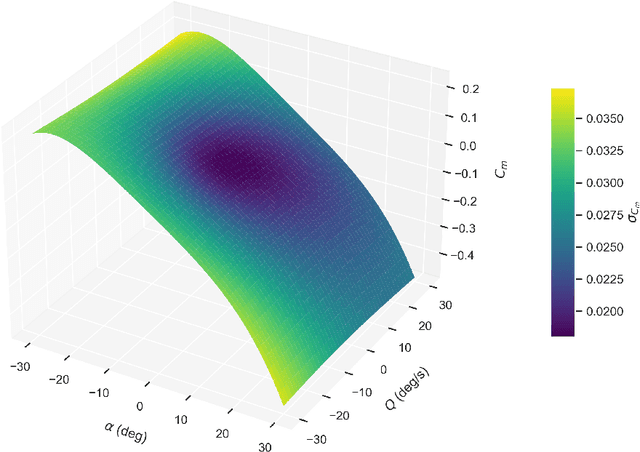
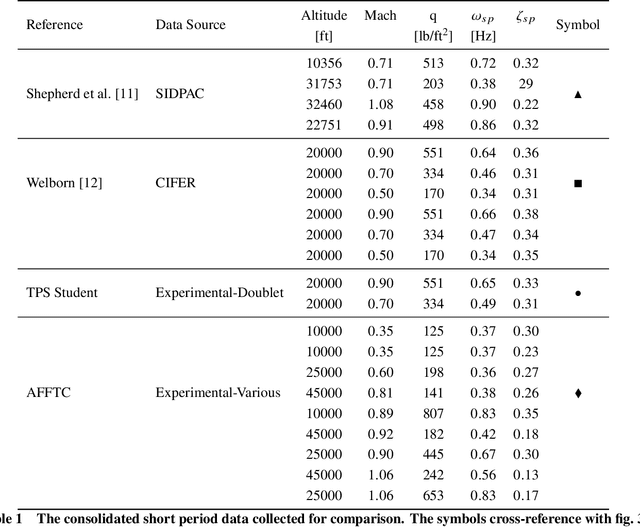
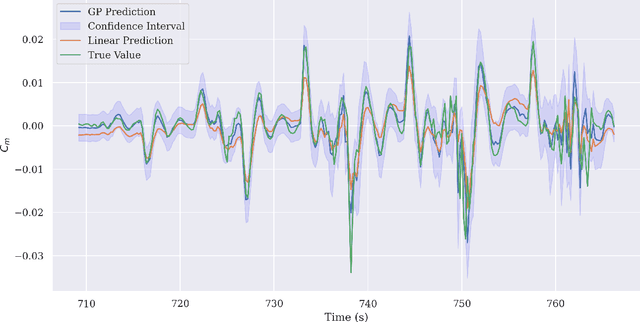

Abstract:Flight test analysis often requires predefined test points with arbitrarily tight tolerances, leading to extensive and resource-intensive experimental campaigns. To address this challenge, we propose a novel approach to flight test analysis using Gaussian processes (GPs) with physics-informed mean functions to estimate aerodynamic quantities from arbitrary flight test data, validated using real T-38 aircraft data collected in collaboration with the United States Air Force Test Pilot School. We demonstrate our method by estimating the pitching moment coefficient without requiring predefined or repeated flight test points, significantly reducing the need for extensive experimental campaigns. Our approach incorporates aerodynamic models as priors within the GP framework, enhancing predictive accuracy across diverse flight conditions and providing robust uncertainty quantification. Key contributions include the integration of physics-based priors in a probabilistic model, which allows for precise computation from arbitrary flight test maneuvers, and the demonstration of our method capturing relevant dynamic characteristics such as short-period mode behavior. The proposed framework offers a scalable and generalizable solution for efficient data-driven flight test analysis and is able to accurately predict the short period frequency and damping for the T-38 across several Mach and dynamic pressure profiles.
 Add to Chrome
Add to Chrome Add to Firefox
Add to Firefox Add to Edge
Add to Edge